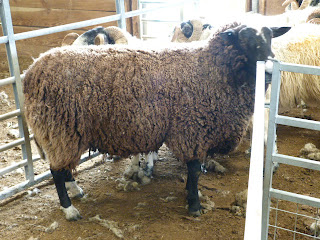Whilst the rest of the country is suffering from Olympic fever, for the Highlands and Islands it is Highland Games time. Though the Games, like the Olympics, date from time immemorial and were a test for warriors, the Games, as we know them today is quite a recent event. In fact they were the idea of an English aristocrat who had a Highland estate in Victorian times. Queen Victoria’s purchase of Balmoral on Deeside is another story but suffice to say she started the trend for wealthy Southerners to own Highland estates.
So our island has its Highland Games. They are held every July on Tobermory Golf Course, high above the town with fantastic views of mainland Scotland, this year it was clear and we could see Ben Nevis. The Sound of Mull was glassy and blue beneath us. You may have guessed by now that the weather was kind though it started out dull and overcast so off we went with un-needed waterproofs. The games start right in the town as the Hereditary Chieftain, Sir Lachlan Maclean and the Games officials form up in front of the Pipe Band to march down Main Street wending the way up Back Brae to the Games field. Everyone going to the games follows the pipe band so by the time the Chieftain arrives at the fields he is followed by hundreds of people who join the march.
We were no different and arrived in the happy sea of humanity. The field is a perfect venue with Highland Dance competitions at one end, the Heavy sports at the other and all enclosed by the running track. Spectators sit on a natural grassy bank above the arena, not too far from the food tent and the bar and able to see all events from one viewpoint. There are Highland dancing and bagpipe playing competitions going on all day, field and track events also. The highlight for the majority of the spectators is the Heavy Events. These are the traditional Highland sports rarely seen outside Highland Games meetings. So 16lb hammers are thrown over 150 feet, a variety of other weights various distances all with much effort by very burly competitors. To ring the changes a 56lb hammer is also thrown over a bar, at the moment the record set in 2011 is 16 feet, a 16lb Ball is putt in the order of 50 feet.
The event known to all is Tossing the Caber. The Caber is a straight tree trunk about 19 feet long and weighing 175lbs. The thrower has to lift the Caber vertically run with it and toss it so that it falls away from him. Sometimes successfully, sometimes it bounces and drops back towards judge and caber tosser who need to get from under. As all this is going on pipe bands entertain, this year the champion Oban High School Band shared the honours with our own Mull and Iona Pipe Band. As the games drew to a close the “heavies” staged a knock out competition heaving a 42lb weight over a bar above their heads, the last competitor breaking the record at 18 feet without breaking his head!!!













